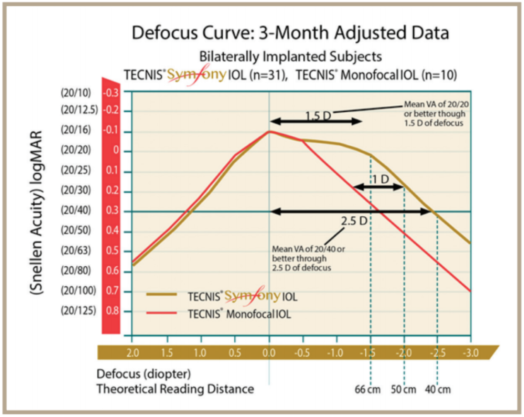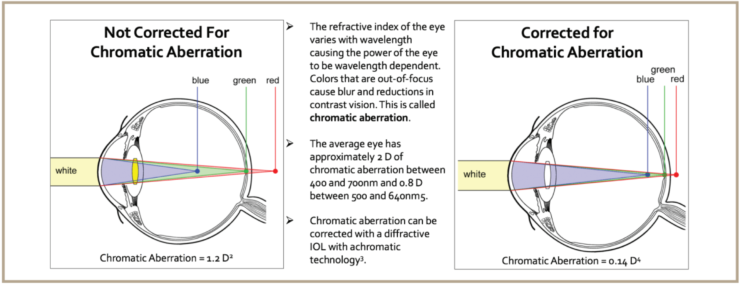Patients wanted an IOL that would allow them to see at all distances, but without the drawbacks of multifocal lenses. The research and development (R&D) team at Abbott Medical Laboratories (now Johnson & Johnson Vision Care), led by Patricia Piers, heard the needs expressed by the ophthalmologic community and delivered just that. The first in a new class of IOL technology, the Tecnis Symfony extended-depth-of-focus IOL (EDOF) delivers patients a full and continuous vision range with the excellent outcomes expected from the Tecnis portfolio.1
Quality vision without compromise
The No. 1 priority of the development team was how to better address presbyopia correction without compromising on the visual quality the entire company’s portfolio is based upon. They began by interviewing numerous cataract surgeons and identified three specific needs:
1. Minimized halo and glare symptoms
2. No reduction in contrast sensitivity
3. No loss in intermediate vision; patients want continuous, natural vision
The idea of creating a product that addressed a real need in the market united the R&D team in this undertaking. “The opportunity to make a genuine impact and improve vision for people invoked a feeling of meaningful purpose for the Symfony development team,” says R&D Director Patricia Piers. “The overall excitement and positive feedback we received from patients and physicians during the initial proof of concept studies fueled our determination to deliver the highest quality lens possible to meet this visual need.” Their concerted efforts resulted in the Tecnis Symfony IOL and Symfony Toric IOL. Study results confirmed success with demonstrated satisfaction of the development goals.1
These EDOF IOLs fill the intermediate vision void. According to James C. Loden, MD, founder and president of Loden iVision Centers in Nashville, TN, presbyopia correcting IOLs are “notorious for inconsistent performance and can behave more like a monofocal lens. Accommodating multifocal lenses give patients distance vision and very good high-quality near vision, but weak intermediate vision and a high incidence of glare and halo at night. The Symfony allows us to offer our patients a continuous range of vision with greatly reduced symptoms of glare and halo. The toric is also a fantastic model, giving us the ability to have a stable presbyopia- correcting platform with distance, intermediate, near, and 2.50 D corneal astigmatism.”
These lenses are beneficial to patients with and without astigmatism, according to Jerry G. Hu, MD, a cofounder of the Texas Eye and Laser Center located in Fort Worth and Hurst, Texas. “In my practice, I have used Symfony and Symfony Toric IOLs in post-refractive surgery eyes with great success. Previously poor candidates for existing presbyopia-correcting IOLs now have a viable option to help reduce how often they wear spectacles for both distance and near,” Hu says.
Proven benefits
A New Zealand multicenter study confirmed the clinical benefits of this EDOF IOL with a 3-month follow-up. Subjects were bilaterally implanted with the EDOF IOL or the Tecnis Monofocal ZCB00 IOL with endpoint testing for defocus, visual acuity, dysphotopsia, spectacle independence, and patient satisfaction. The study demonstrated the EDOF IOL’s ability to deliver outstanding visual acuity over a continuous range of distances while maintaining contrast performance in any lighting condition.1
One fortuitous consequence of the EDOF IOL continuous vision product is that it is more robust to residual astigmatism than existing multifocals, according to Dr. Hu. This is equally true for the toric lenses. Symfony subjects demonstrated 20/20 or better sustained mean visual acuity through 1.50 D of defocus and a 1.00 D increase in range throughout the defocus curve.1 As a participant during the EDOF IOL FDA trials, Dr. Hu says he observed a unique tolerance for residual refractive astigmatism (Figure 1). “Patients could see very well despite having up to 1.50 D of refractive cylinder,” he says. “The lens is very forgiving even if we miss the astigmatic target.”

Image courtesy of J&J Vision
FIGURE 1. Defocus curve for patients with EDOF lenses.

Image courtesy of J&J Vision Care
FIGURE 2. This lens offers a unique optic design and low chromatic aberration.
Achromatic technology integrated within the diffractive surface causes contrast enhancement and higher image quality. When combined with spherical aberration correction, retinal image quality increases without negatively affecting depth of focus (Figure 2).2,3
“The unique optic design and low chromatic aberration of Symfony and Symfony Toric IOLs produce unparalleled visual quality,” says Dr. Hu. “We know that Snellen chart measurements are not reflective of patient satisfaction; a waxy 20/20 does not equate to a crystal clear 20/20. When we collect our post-op surveys, the word ‘happy’ continuously jumps out; most of my patients are genuinely happy with how they see.”
EDOF IOL study subjects had 20/20 or better mean distance and intermediate visual acuity, and a 2-line improvement in mean intermediate and near visual acuity.1 EDOF IOL subjects experienced high spectacle independence at far, intermediate, and near distances. Additionally, these study subjects reported low visual symptom occurrence (glare or halo) compared to a monofocal IOL postoperative or at 3 months postoperative follow-up visit.1
“Functional near vision has been a pleasant surprise,” says Dr. Hu. “With the optic design featuring an EDOF of +1.75 D, we initially expected superior intermediate vision but limited near vision; hence we selected and counseled our first group of patients accordingly. However, my personal experience with 200 cases over 6 months shows the vast majority of my patients can read J1, J2, or J3 at near with a very fluid reading speed and high level of satisfaction. The majority of my patients achieve spectacle independence for most of their reading needs.”
Selecting the right patient
Recognizing that successful outcomes and patient satisfaction largely depend upon matching the right IOL to the patient, it is still important to understand each patient’s specific needs and tailor our approach in determining surgical plans,” reminds Dr. Loden. To avoid unmet patient expectations, pre-op counseling must include a discussion about the acceptability of reading glasses for some patients, particularly those who frequently read fine print or perform near vision tasks, such as embroidery.
These lenses are leading in the next generation of IOL technology. Dr. Hu adds that, “With their exceptional quality of vision, highly functional near vision, great night vision profile, forgiveness for residual astigmatism, and broad clinical indications, Symfony and Symfony Toric IOLs are easy recommendations for me to make for my most discerning patients.”
1. AMO. Data on File_Extended Range of Vision IOL 3-Month Study Results (NZ).
2. Weeber, HA, Piers PA. Theoretical performance of intraocular lenses correcting both spherical and chromatic aberration. J Refr Surg. 2012;28(1):48-52.
3. Artal P, Manzanera S, Piers P, Weeber, H. Visual effect of the combined correction of spherical and longitudinal chromatic aberrations. Opt Express. 2010;18:18(2):1637-1648.
Drs. Hu and Loden serve as consultants to Johnson & Johnson Vision Care.


